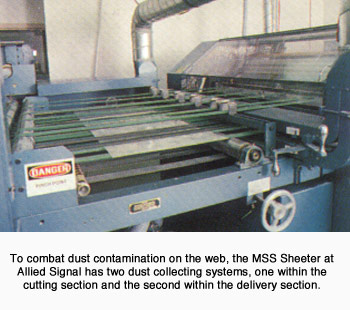A Wisconsin converter of laminate systems has found investing in a new sheeter has brought major production benefits, including labor savings and improved quality.
Since 1958 Allied Signal Laminate Systems, La Crosse, WI, has been a quality producer of prepreg and laminates for circuit-board industry. The firm’s product line is used for high-end military and computer application by customers such as IBM, Compaq, Hewlett Packard, Unisys, Hughes Aircraft, Cray and Honeywell.
 Allied Signal has an extensive manufacturing and distribution network with facilities in: Chandler, AZ; Postville, IA; Hoosick Falls, NY; Pendleton, SC; La Crosse, WI; Thailand; Taiwan; and Germany. In 1991, the firm acquired Westinghouse Corp., making it one of the world’s largest circuit-board laminators.
Allied Signal has an extensive manufacturing and distribution network with facilities in: Chandler, AZ; Postville, IA; Hoosick Falls, NY; Pendleton, SC; La Crosse, WI; Thailand; Taiwan; and Germany. In 1991, the firm acquired Westinghouse Corp., making it one of the world’s largest circuit-board laminators.
At Allied Signal’s La Crosse plant, the company employs 400 workers. The manufacturing process begins with a fiberglass-cloth roll. The web is drawn through a treater line that coats the cloth with a resin and dries it.
The treated stock is rewound and sheeted off-line on a drop-shear cutter. The sheeted material goes through several other processes before it’s packaged and sold as a circuit-board laminate or prepreg panels.
As the computer industry has grown and evolved, so has demand for Allied Signal’s product line. The La Crosse facility manufactures 18 different styles of glass-treated material with an emphasis on short runs and small sizes.
With this business on the increase, the company found its sheeting operation needed more capacity. Until recently, the company sheeted its material on three drop-shear cutters, which were slow and labor intensive. Cleanliness was also a concern.
“For our operation, cleanliness is a major consideration,” Dave Plantz, manufacturing engineer at Allied Signal, said. “The exacting nature of our product means we can’t have any grease, dirt, or lint on the stock. As we were moving toward a clean-room environment, it became essential to have a sheeter that could cut our material cleanly and faster.”
Allied Signal’s sheeter investigation included talking to other plants within the company. “We heard that our sister plant in Hoosick Falls had bought a Maxson sheeter,” Plantz said. “We visited their facility and saw what it could do.”
After careful evaluation, Allied Signal selected the MSS sheeter from Maxson Automatic Machinery Co., Westerly, RI.
 The sheeter handles five or six different resin systems ranging in thickness from 2 mil up to 8 mil. “We sheet all but our very lightweight stock on the Maxson,” Plantz said. The new sheeter operates consistently between 75 fpm and 100 fpm representing a fourfold increase in production. “We’re doing the same things that we did previously on our other sheeters, but the difference is we can do them much faster now with less setup time. As a result of the Maxson unit’s sheeting capacity, Allied Signal has idled its three existing sheeters.
The sheeter handles five or six different resin systems ranging in thickness from 2 mil up to 8 mil. “We sheet all but our very lightweight stock on the Maxson,” Plantz said. The new sheeter operates consistently between 75 fpm and 100 fpm representing a fourfold increase in production. “We’re doing the same things that we did previously on our other sheeters, but the difference is we can do them much faster now with less setup time. As a result of the Maxson unit’s sheeting capacity, Allied Signal has idled its three existing sheeters.
To address Allied Signal’s concern about cleanliness, the MSS sheeter has a dust-collecting system within the cutting section to combat any slitter-dust contaminants. Synthetic tapes were substituted for the standard cotton tapes in the sheeter’s delivery system to allow for easy of cleaning. As a final insurance against dust, a PEN MAM dust collector was installed in the sheeter’s delivery section.
The MSS sheeter’s close-tolerance drive provides an accurate cutoff with no guillotine trimming required. The sheeted stock collects in a neatly jogged pile at the stacker. “With the Maxson, our pile quality has improved measurably,” Plantz said.
Sheeting-department productivity has also improved. “One operator on the Maxson can now do the work that normally took three operators to do on our other sheeters,” Plantz said.
With the flexibility to turn orders around more quickly. Plantz estimates Allied Signal now saves half a week in its production schedule without comprising the quality of its product.
As the circuit-board industry and its capabilities continue to evolve, Allied Signal is poised to react to the changes by providing a quality product more cost effectively.
Reprinted from Paper Film Foil Converter, October 1994






